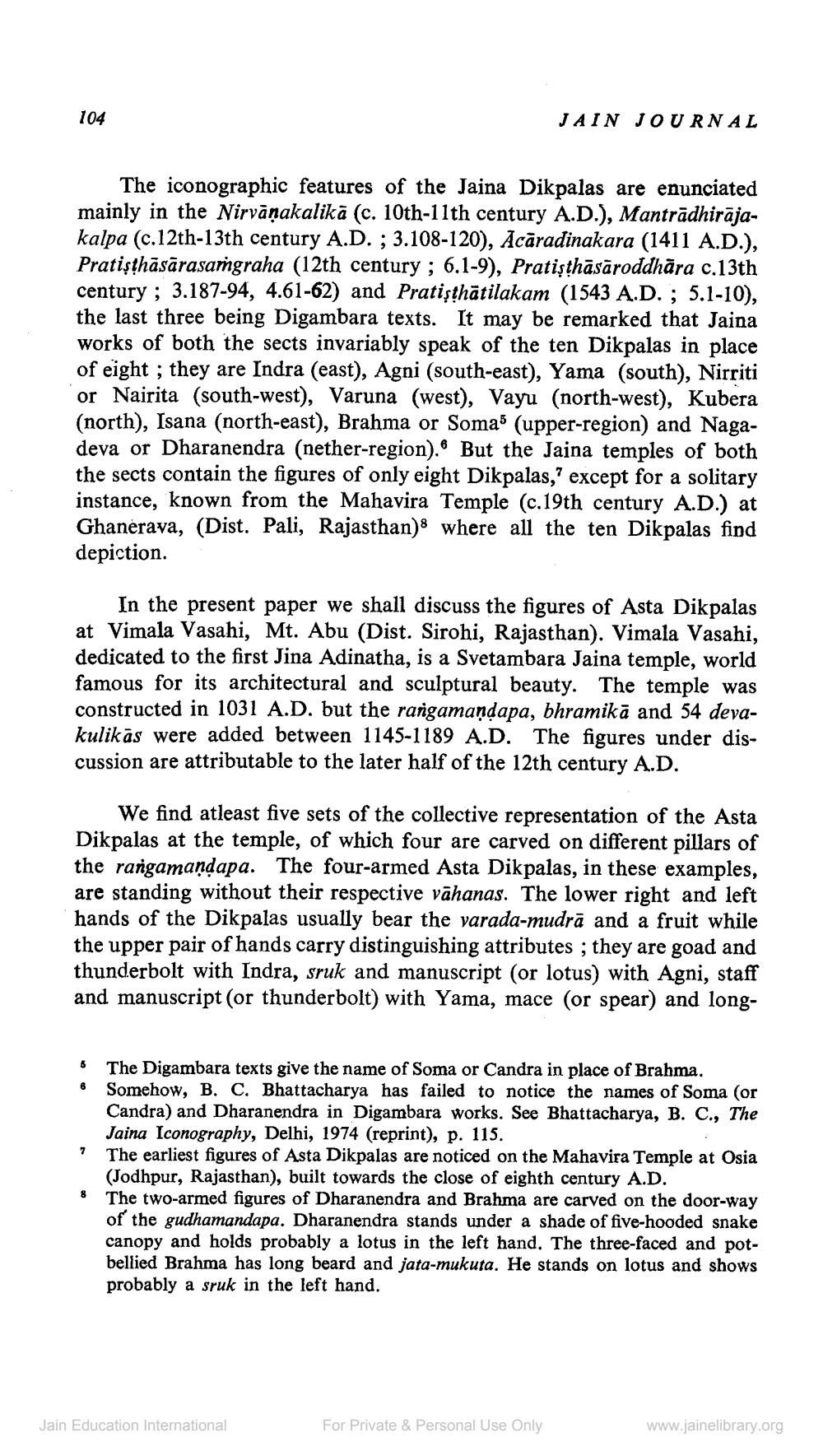________________
104
The iconographic features of the Jaina Dikpalas are enunciated mainly in the Nirvāṇakalikā (c. 10th-11th century A.D.), Mantrādhirājakalpa (c.12th-13th century A.D.; 3.108-120), Acaradinakara (1411 A.D.), Pratisthāsarasamgraha (12th century; 6.1-9), Pratiṣṭhāsāroddhāra c.13th century; 3.187-94, 4.61-62) and Pratisthätilakam (1543 A.D.; 5.1-10), the last three being Digambara texts. It may be remarked that Jaina works of both the sects invariably speak of the ten Dikpalas in place of eight; they are Indra (east), Agni (south-east), Yama (south), Nirriti or Nairita (south-west), Varuna (west), Vayu (north-west), Kubera (north), Isana (north-east), Brahma or Soma" (upper-region) and Nagadeva or Dharanendra (nether-region). But the Jaina temples of both the sects contain the figures of only eight Dikpalas,' except for a solitary instance, known from the Mahavira Temple (c.19th century A.D.) at Ghanerava, (Dist. Pali, Rajasthan) where all the ten Dikpalas find depiction.
In the present paper we shall discuss the figures of Asta Dikpalas at Vimala Vasahi, Mt. Abu (Dist. Sirohi, Rajasthan). Vimala Vasahi, dedicated to the first Jina Adinatha, is a Svetambara Jaina temple, world famous for its architectural and sculptural beauty. The temple was constructed in 1031 A.D. but the rangamandapa, bhramika and 54 devakulikās were added between 1145-1189 A.D. The figures under discussion are attributable to the later half of the 12th century A.D.
JAIN JOURNAL
We find atleast five sets of the collective representation of the Asta Dikpalas at the temple, of which four are carved on different pillars of the rangamaṇḍapa. The four-armed Asta Dikpalas, in these examples, are standing without their respective vahanas. The lower right and left hands of the Dikpalas usually bear the varada-mudrā and a fruit while the upper pair of hands carry distinguishing attributes; they are goad and thunderbolt with Indra, sruk and manuscript (or lotus) with Agni, staff and manuscript (or thunderbolt) with Yama, mace (or spear) and long
6
5 The Digambara texts give the name of Soma or Candra in place of Brahma. Somehow, B. C. Bhattacharya has failed to notice the names of Soma (or Candra) and Dharanendra in Digambara works. See Bhattacharya, B. C., The Jaina Iconography, Delhi, 1974 (reprint), p. 115.
The earliest figures of Asta Dikpalas are noticed on the Mahavira Temple at Osia (Jodhpur, Rajasthan), built towards the close of eighth century A.D.
7
8 The two-armed figures of Dharanendra and Brahma are carved on the door-way of the gudhamandapa. Dharanendra stands under a shade of five-hooded snake canopy and holds probably a lotus in the left hand. The three-faced and potbellied Brahma has long beard and jata-mukuta. He stands on lotus and shows probably a sruk in the left hand.
Jain Education International
For Private & Personal Use Only
www.jainelibrary.org




